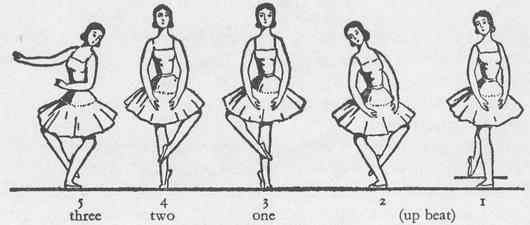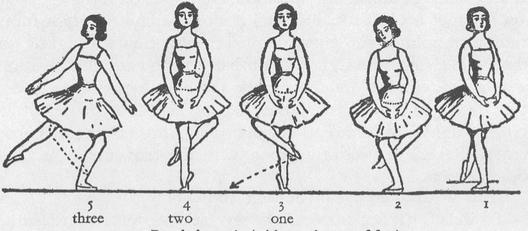Basic Principles of Classical Ballet (12 page)
Read Basic Principles of Classical Ballet Online
Authors: Agrippina Vaganova

38. Écarté back and écarté front
As a matter of fact, écarté is a développé in 2nd position, opened as widely as possible. In this pose one should pay special attention to the shoulders. In spite of the bend to the side the shoulders must not lose their line, and one shoulder must not be higher than the other.
VI
CONNECTING & AUXILIARY MOVEMENTS
PAS DE BOURRÉE
IN CLASSICAL ballet, to move from one spot to another, a dance step is used and not an ordinary walking one. One of the most widely used for this purpose is pas de bourrée.
Pas de bourrée has several variations, and it is done in all possible directions.
For a long time we used the soft, unemphasized pas de bourrée of the French school. With the strengthening influence of the Italian school in the nineteenth century, pas de bourrée changed in character. Now the foot is lifted sharply, the entire movement is defined in higher relief. I accepted this style after having tried it out in practice.
One must be careful that the foot leaves the ground smartly, both in the early stages of study on half-toe, and later on pointe.
Pas de bourrée is divided into two basic forms: with a change of feet, and without a change of feet. In the first instance, if you start with the right foot front, you will end with the left in front; in the second, the right foot remains in front.
PAS DE BOURREE WITH CHANGE OF FEET
To familiarize the pupil with pas de bourrée in the beginners’ classes, the form with a change of feet is employed.
Stand croisé, left foot pointed behind (right sole entirely on the floor). Arms in preparatory position. Demi-plié on right leg. Step on left foot on half-toe, bringing it close behind the right foot; right foot pointed sur le cou-de-pied front and raised slightly on the left leg, step onto right foot on half-toe, toward 2nd position without moving too much from the spot; left foot sur le cou-de-pied front, as described above. Fall on left foot in demi-plié croisé. Right foot sur le cou-de-pied back. Arms take a small pose croisé. Repeat on the other foot, with the movement into the other direction.
Thus is executed pas de bourrée en dehors.
To execute pas de bourrée in the reverse direction, i.e. en dedans, begin in the pose croisé forward with the left foot pointed in front. Demi-plié on right foot (left foot—sur le cou-de-pied front), stand on left foot on half-toe, bringing it close to the right foot, raise right foot sur le cou-de-pied back, change to right foot on half-toe toward the 2nd position, not moving too much from the spot, left foot sur le cou-de-pied back, fall on left foot in demi-plié, in croisé, right foot sur le cou-de-pied front.

39. Pas de bourrée (with change of feet)
With a series of such movements one may begin the study of pas de bourrée. Special care must be exercised that the feet are well lifted, that the toes are forcefully extended and pointed.
This teaches the sole of the foot to work in pas de bourrée, so that with increase in tempo, the sole will not be dead, but will move, if not exactly with the same sharpness as at the beginning of the study, at least it will participate in the movement.
PAS DE BOURRÉE WITHOUT CHANGE OF FEET
This pas de bourrée is done with the leg opening at the conclusion of the step and travelling to the side. When making the step to the side, the legs must not be held too far apart.

40. Pas de bourrée (without change of feet)
Stand in a pose croisé, left foot behind. Arms are in preparatory position. Starting the movement, raise them the least bit and return to the same pose. Demi-plié on right leg, step on left foot on half-toe, right foot sur le cou-de-pied front (same as in preceding form of pas de bourrée). Step on right foot on half-toe, with movement to the right; left foot sur le cou-de-pied back. Fall on left foot in the demi-plié, right foot opens to 2nd position at an angle of 45°; the arms open in a low 2nd position.
To continue, step on right foot and repeat the same movement from the other foot to the left.
I repeat all these movements can be done in any direction: forward, back, in effacé, croisé, and écarté.
If you do pas de bourrée without change of feet in écarté, then at the movement to the right, when you stop, the right leg will be in écarté forward, and when moving in the opposite direction, to the left, the left leg will open in écarté back.
PAS DE BOURRÉE DESSUS—DESSOUS
In translation
dessus
means
over,
and the leg that is opened at the beginning of the movement goes forward first, replacing the other leg.
Dessous
means
under,
and the leg that is opened at the beginning of the movement goes behind, replacing the other leg. One may add, that in the first case the leg, as it were, goes over the other leg, and in this manner sur le cou-de-pied is always at the back of the stepping foot. In the second case, it goes under the other leg, and sur le cou-de-pied is always in front of the stepping foot.
Pas de bourrée dessus-dessous, as well as all other forms of pas de bourrée is taught at the beginning on half-toe.
1.
Dessus.
Stand in 5th position, right foot front. Arms in preparatory position. Demi-plié on right leg, open left leg to 2nd position at an angle of 45°, and step on it on half-toe, bringing it in front of the right leg;
19
the right rises at back sur le cou-de-pied, as in the preceding cases; the arms slowly open to a low 2nd position toward the end of the movement. Step on to right foot on half-toe, bringing it in front of the left; the left rises at the back sur le cou-de-pied (the same way). Fall on left leg in demi-plié; the right opens to 2nd position at 45°. The entire movement is done to the right.

41. Pas de bourrée dessus sur les pointes

42. Pas de bourrée dessous sur les pointes
The arms gradually join in the preparatory position, and open to a low 2nd position at the end of the movement.
2.
Dessous.
5th position; demi-plié on left foot opening right leg to 2nd position and step on right foot on half-toe, left foot sur le cou-de-pied front. Step on left foot on half-toe behind the right foot, right foot sur le cou-de-pied front (the same way). Fall on right foot in demi-plié, left leg opens to 2nd position at 45°. Repeat entire movement to the left. Arms are moving as in the preceding example.
When first studying pas de bourrée the accent is made on the concluding plié. Eventually, however, the movement changes into an unaccented form, one pas smoothly following the other.
PAS DE BOURRÉE EN TOURNANT
In the dance this movement is often joined with another, serving as a preparation for it.
All described types of pas de bourrée can be done en tournant. As an example we shall analyze the following case:
Pas de bourrée en dedans
. Stand in 5th position, right foot front. Demi-plié on right leg opening the left leg into 2nd position at 45°. While stepping on the left foot on half-toe, do a half-turn to the right, the right foot slides sur le cou-de-pied front. Finish the turn on right foot on half-toe, left foot sur le cou-de-pied back. Fall on left foot into plié, right foot sur le cou-de-pied front.

43. Pas de bourrée en tournant en dedans
From this movement you can continue pas de bourrée en dehors in the following manner:
Demi-plié on left leg, open right leg into 2nd position at 45°, stepping on right foot on half-toe, do a half-turn to the right; left foot slides back sur le cou-de-pied. Complete the turn on left foot, right foot sur le cou-de-pied front, and fall on right foot in plié, opening left leg into 2nd position at 45°.

44. Pas de bourrée en tournant en dehors
The arms open at the beginning of the step into 2nd position at half-height, close into preparatory position during pas de bourrée, and open into any position required, depending on the step to follow.
The head faces the spectator as long as possible, and then follows the turn of the body.